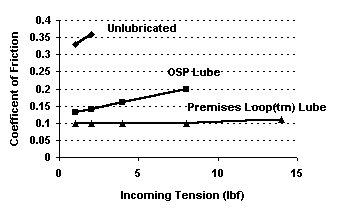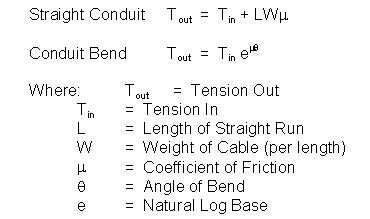| |
|||||||||
| |
|
|
|
|
|
|
|
||
| Home | About | Literature | Site Map | MSDS | Contact | Engineers | Shows | Links | Samples | RFQ | Catalog Numbers |

As communication and data networks are installed in harsh industrial environments, more and more lightweight cable (fiber optic, shielded copper, coaxial, or hybrid) is being placed in conduit for protection. When such cable is pulled into conduit, there are significant differences from the installation of its "outside plant" counterpart. This TeleTopics will review these differences. While the data presented is for premises fiber optic cable, the principles apply to most lightweight cable.
Maximum Tension
Indoor cables are much smaller and lighter in weight than outdoor cables. This light weight makes them easy to handle and install. However, the tensile strength and maximum pulling tension for premises cables is much lower than for outdoor cable.
A tension maximum for a cable is usually expressed in units of lbs force (lbf) or Newtons (N). The Newton is a metric measure of force equal to 10exp5 dynes or 4.45 lbf. To convert a Newton force to a pound force, divide it by 4.45. For example, a maximum pulling tension of 100 Newtons converts to 22.5 lbf.
Six hundred lbf (2700 N) is a typical maximum tension for outside plant fiber optic cable. Tensions for premises cable depend on cable construction. Tensions for fiber optic premises cable can be as low as 25 lbf (110 N), and are often lower than 100 lbf (440 N). An installer can easily exert 25 lbs of force (110 N) with a single arm. Attention and care are clearly needed to respect the tension limits of indoor cable.
Pulling Bundled Cables
The pulling of multiple cables into a single conduit is much more common in building environments than in outside plant construction. If we know the maximum tension allowable on a single cable, what is a safe maximum tension for a "bundle" of the cables? The question is how many and which cables are supporting the pulling load in a bundle of cables?
There is some precedent for maximum bundle tension from electrical control cable installation, where the total of the tensiles for all cables is lowered by 20% to 50%, depending on specifics. Consult with the cable's manufacturer for their recommendations on maximum tension for single and multiple cable pulls.
Cable Jacket
Carbon black loaded polyethylene (HDPE, MDPE) is the predominant outside plant cable jacket. Indoor cables, on the other hand, are often color coded (orange, yellow, or white). The jackets tend to be fire resistant materials such as PVC, PTFE, and PVDF. Because of these jacket differences, the pulling properties and friction character of indoor cable is very different from outdoor cable.
Conduit/Lubricant Viscosity
When outside plant cables are pulled, the conduit systems are usually underground. The duct is often continuous HDPE (innerduct), PVC, or multi-cell type. Pourable lubes, like Polywater® F or Network Loop™ Lube with Silicone are used. It's fast and convenient to pour the pulling lubricant into the cable feeder tube or upturned duct before you start the pull and as needed throughout the pull.
The conduit in an indoor system may be steel, PVC, or one of the newer continuous tube "premises" ducts. Regardless, the type of pulling and lubricant application method is different from an outside plant pull. It is common in industrial pulling for conduit (and the cable pull) to go up walls and across ceilings. Cable feeding is often overhead and on cables going up. Liquid lubricants are simply not practical to apply. Strong gel lubricants are needed, like Premise Loop™ Lubricant, which clings to the cable and doesn't back flow.
Tension Reduction
With everything else equal (cable weight, conduit layout, etc.), the best way to lower cable pulling tension is to reduce the friction of the cable jacket against the conduit wall. Friction is measured by a dimensionless constant called coefficient of friction (COF) or friction coefficient. Studies have shown that friction coefficient varies with cable jacket type, conduit type, temperature, and pulling lubricant type.
The data below are friction coefficients for "premises" fiber cable in "premises" duct from a "multi-bend" pulling test. This test controls the input (back) tension on a cable and measures the pulling tension through a series of conduit bends. From these measurements, a coefficient of friction can be determined. See TeleTopics Volume X for a more detailed theoretical discussion of this method.
The tests involved a number of distribution cables and pulling lubricants. There is too much data to present here. The graph below is representative. It plots the calculated COF (coefficient of friction) against the incoming (back) tension.

The graph shows the cable has an unlubricated COF in this duct of 0.33 to 0.36. American Polywater's Premise Loop™ Lube (a gel) lowers the friction coefficient more than the common "outside plant" (liquid) lube. The Premise Loop™ Lube was designed to work with the jackets and conduits typical of indoor cables.
Both lubricants significantly lower the friction coefficient compared to the unlubricated, and thus will reduce the pulling forces needed to install the cable. But how much?
Relating Friction to Tension
How can we know what a reduced friction coefficient means in any specific cable installation? Can we make the pull with less than the cable's maximum load? Can we safely pull farther and thus save money?
The cable pulling equations relate friction coefficient to cable pulling tension. A simplified form of the equations will clarify:

Note how significant the friction coefficient is in determining tension. In bends, the friction coefficient is in an exponent which multiplies the incoming tension. In pulls with a few bends, COF reduction of 50 to 65% (as seen in the graph) can reduce pulling tension by factors of 5 to 10!!
Pull-Planner™ 3000 Software
The actual pulling equations are considerably more complex than the simplified forms shown above. American Polywater's Pull-Planner™ 3000 Software allows easy estimation of pulling tensions on a PC. It enables "what if" scenarios with cable, conduit, pull length, COF, incoming tension, and more. The software has an internal data base with measured friction coefficients for many jacket and conduit types.
Summary
Unnecessary high tension can damage cable, costing both time and money. The use of high performance pulling lubricants and the science of tension estimation can help prevent cable damage during installation. However, the lubricants that served so well for the pulling of polyethylene jacketed outside plant cable are not as effective on indoor cables. Premise Loop™ Lube was developed for this type of cable and provides outstanding friction reduction.
View this article En Español!
View this article in PDF Format
Free 12-minute training video on Fiber Optic Cable Pulling & Lubrication
For Subscriptions, Comments, or Questions contact: tteditor@polywater.com
Home |
About |
Site Map |
Literature |
Samples |
Links |
Reps |
Videos |
Pumps |
RFQ
Codes |
Engineering |
Shows |
Spotlight |
Newsletters |
MSDS |
Translations |
Contacts |
Jobs

11222 60th ST N | Stillwater, MN 55082-9310 USA
1-(651) 430-2270 (Voice) | 1-(651) 430-3634 (Fax)
1-(800) 328-9384 (Toll-Free US/Canada Only)
Copyright © 2001 - 2015 American Polywater Corporation | ![]() 6/5/15
6/5/15